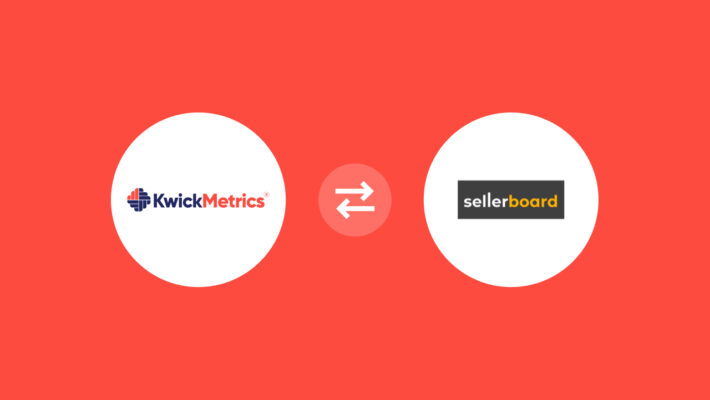Walmart Seller Tools: Your Key to Marketplace Success

Table of Contents
- Walmart Seller Tools
- Understanding Sales Analysis
- Interested to view how a sample Profit and Loss Report looks and what all it covers?
- Exploring Profit and Loss Analytics in Walmart Seller Tool
- How Sales Analytics Helps Walmart Sellers?
- KwickMetrics - The Business Intelligence and Analytics Tool
- How Profit and Loss Analytics Benefits Walmart Sellers?
- FAQs In relation to Walmart Seller Tools
- Conclusion
Walmart Seller Tools
The Walmart Seller Tool is a third-party solution provider like KwickMetrics, offering various analytics tools for Walmart sellers on Walmart Marketplace. It provides sales analytics, profit and loss analysis, and other valuable insights to help sellers optimize their performance on the platform. By utilizing these tools, Walmart sellers can enhance their visibility, boost sales, and streamline their operations.
Understanding Sales Analysis
- Walmart Sales analysis is understanding how your products are selling in Walmart stores or online..
- It provides sellers with comprehensive insights into their sales performance on the Walmart Marketplace.
- Sellers can access various metrics such as total sales orders, units, revenue, trends, and many other metrics. SKU wise details can also be accessed.
- These metrics allow sellers to track their sales trends over time and understand their customer base better.
- Walmart Sales analytics helps sellers identify top-selling products, best-performing categories, and peak selling periods.
- By analyzing sales data, sellers can make informed decisions about inventory management, pricing strategies, and marketing efforts.
- Walmart Sales analytics empowers sellers to optimize their sales strategies and maximize their revenue potential on the Walmart Marketplace.
Interested to view how a sample Profit and Loss Report looks and what all it covers?
Exploring Profit and Loss Analytics in Walmart Seller Tool
- Profit and loss analytics is a valuable feature available within Walmart seller tools like KwickMetrics.
- This feature provides sellers with insights into the financial performance of their Walmart Marketplace business.
- Sellers can track metrics such as revenue, expenses, and net profit over a specified period.
- Profit and loss analytics help sellers understand their business’s profitability and identify areas for improvement.
- By analyzing financial data, sellers can make informed decisions about pricing, inventory management, and marketing strategies.
- This feature enables sellers to optimize their operations, reduce costs, and maximize profits on the Walmart Marketplace.
- Profit and loss analytics is essential for Walmart sellers to maintain financial health and sustain a successful Walmart business.
Overall, profit and loss analytics empower Walmart sellers to effectively manage their finances, optimize their pricing and inventory strategies, and maximize their Walmart profit margin on the Walmart Marketplace.
Key Takeaway:
Optimization through Analytics: Walmart Seller Tools, including sales and profit/loss analytics, empower sellers to optimize their performance, inventory management, pricing strategies, and marketing efforts on the Walmart Marketplace.
How Sales Analytics Helps Walmart Sellers?
- Insight into Performance: Sales analytics provides Walmart sellers with valuable insights into their performance metrics, including total sales, order volume, and revenue trends. By understanding their sales data, sellers can assess their business’s health and identify areas for improvement.
- Identifying Trends: With sales analytics, sellers can identify trends in customer behavior and product performance. They can track which products are selling well, understand customer preferences, and anticipate demand shifts. This information allows sellers to adjust their strategies accordingly, such as stocking popular items or targeting specific customer demographics.
- Optimizing Inventory Management: Sales analytics helps sellers optimize their inventory management by providing data on stock levels, turnover rates, and product popularity. Sellers can ensure they have the right products in stock at the right time, minimizing stockouts and reducing carrying costs.
- Pricing Strategies: By analyzing sales data, sellers can evaluate the effectiveness of their pricing strategies. They can identify pricing trends, assess competitor pricing, and adjust prices accordingly to remain competitive while maximizing profitability.
- Marketing Effectiveness: Sales analytics can also help sellers evaluate the effectiveness of their marketing efforts. By tracking sales performance before and after marketing campaigns, sellers can measure ROI and adjust their marketing strategies to focus on the most successful channels and tactics.
- Customer Insights: Sales analytics provides valuable insights into customer preferences, repeated buyers, new buyers. Walmart sellers can use this information to tailor their product offerings, marketing messages, and customer service to better meet the needs of their target audience.
Overall, sales analytics empowers Walmart sellers to make data-driven decisions, optimize their operations, and drive business growth on the Walmart Marketplace.
KwickMetrics - The Business Intelligence and Analytics Tool
Explore 14-day free trial! No credit card required, cancel at any time.
How Profit and Loss Analytics Benefits Walmart Sellers?
- Financial Visibility: Profit and loss analytics provide Walmart sellers with a clear understanding of their financial performance. Sellers can track revenue, expenses, and net profit over time, gaining visibility into the financial health of their Walmart business.
- Identifying Profitable Products: By analyzing profit and loss data, sellers can identify which products are generating the most profit and which ones may be costing them money. This insight allows sellers to focus on promoting and stocking high-profit items, maximizing their overall profitability.
- Cost Management: Profit and loss analytics help sellers identify areas where costs can be reduced or optimized, contributing to Walmart loss prevention. By analyzing expenses such as advertising, shipping, and operational overhead, sellers can identify inefficiencies and implement cost-saving measures to improve their bottom line.
- Pricing Strategy Optimization: Sellers can use profit and loss analytics to evaluate the profitability of different pricing strategies. By analyzing the impact of pricing changes on profit margins, sellers can adjust their pricing strategies to maximize profitability while remaining competitive.
- Inventory Management: Profit and loss analytics can also inform inventory management decisions. Sellers can analyze the profitability of different products and adjust their inventory levels accordingly. This helps sellers avoid overstocking low-profit items and minimize inventory holding costs.
- Business Performance Evaluation: Profit and loss analytics provide sellers with a comprehensive view of their Walmart business performance. Sellers can track key financial metrics over time and compare performance across different periods. This insight enables sellers to evaluate the effectiveness of their strategies and make informed decisions to drive business growth.
Overall, profit and loss analytics empower Walmart sellers to effectively manage their finances, optimize their pricing and inventory strategies, and maximize their profitability on the Walmart Marketplace.
Key Takeaway:
Financial Visibility and Management: Profit and loss analytics provide sellers with clear financial visibility, enabling them to identify profitable products, manage costs, optimize pricing strategies, and make informed decisions to maximize profitability.
FAQs In relation to Walmart Seller Tools
What are Walmart Seller Tools?
Walmart Seller Tools are third-party solutions like KwickMetrics, offering analytics tools for Walmart Marketplace sellers to optimize performance, boost sales, and streamline operations.
What is Walmart Sales Analysis?
It provides comprehensive insights into sales performance, helping sellers track trends and make informed decisions about inventory, pricing, and marketing.
How does Profit and Loss Analytics benefit Walmart sellers?
It offers financial visibility, identifies profitable products, optimizes pricing strategies, manages costs, and evaluates business performance.
Why are Sales Analytics important for Walmart sellers?
It provides insights into performance metrics, identifies trends, optimizes inventory management, pricing strategies, marketing effectiveness, and customer insights.
How can Walmart Seller Tools help sellers succeed?
By empowering sellers with valuable insights, optimizing operations, and maximizing profitability on the Walmart Marketplace, these tools ensure long-term success in the competitive e-commerce landscape.
Conclusion
In conclusion, Walmart Seller Tools offer invaluable resources for sellers to effectively manage their businesses on the Walmart Marketplace. From sales analytics providing insights into performance and customer behavior to profit and loss analytics enabling financial visibility and optimization, these tools empower sellers to make informed decisions, streamline operations, and drive business growth. By leveraging these tools effectively, Walmart sellers can enhance visibility, boost sales, reduce costs, and ultimately maximize profitability on the Walmart Marketplace, ensuring long-term success in the competitive e-commerce landscape.



